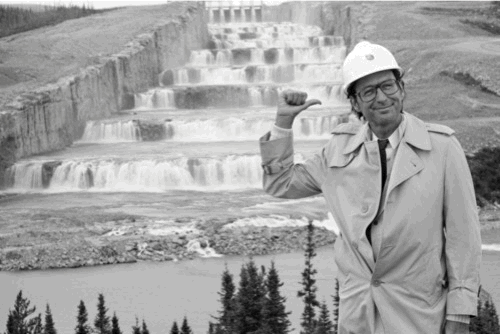
“
Never let it be said that we shall live like paupers on a land this rich.
In 1971, Quebec Premier Robert Bourassa, a man driven by a vision of a modern, economically powerful Quebec, stood before his party and unveiled a project of almost unimaginable scale: the damming of the rivers of James Bay. Fresh from an election victory won on the promise of "100,000 jobs," Bourassa, an economist by training, saw Quebec's northern wilderness not as an untouched ecosystem, but as a vast, untapped source of power that could secure the province's future.
The "project of the century," as it was dubbed, was an audacious display of state-driven development. The plan was to harness the immense power of La Grande Rivière and divert three other major rivers into its watershed, effectively re-engineering the hydrology of a 350,000-square-kilometer territory. At its heart was the construction of the LG-2 generating station, a behemoth built deep underground, which would become the largest of its kind on the planet. To even begin, an army of workers first had to carve a 620-kilometer road into the remote wilderness, a feat they accomplished in a breathtaking three years.
This monumental undertaking was pushed forward with relentless speed, a direct reflection of Bourassa's political will. He framed the project as a decisive step towards modernity, a clean energy solution that would make Quebec "masters in our own house." However, this vision was pursued with a glaring omission. The Bourassa government launched the project with no environmental assessment and, crucially, without any consultation with the 5,000 Cree and 4,000 Inuit people whose lives and ancestral lands would be forever altered.
The ensuing Indigenous-led legal challenge culminated in the landmark James Bay and Northern Quebec Agreement (JBNQA) in 1975, which was Canada’s first modern indigenous treaty, one that has been used as a framework ever since. While the agreement provided the Cree and Inuit with compensation and a degree of administrative control, it came at the cost of extinguishing their pre-existing claims to the land, a bitter pill that secured the project's continuation.
Robert Bourassa's legacy is forever tied to the concrete and steel that tamed James Bay's rivers. The project was a triumph of engineering that transformed Quebec into a hydroelectric superpower, creating a powerful engine for economic growth. It solidified Quebec's control over its territory and provided a powerful, federalist counter-narrative to the era's growing separatist movement. Canada, and specifically the interventionist Quebec state forged during the Quiet Revolution, provided the political and financial muscle to execute a vision on a scale few other jurisdictions could contemplate. Yet, this nation-building endeavor came at a significant environmental and human cost, a complex and dual legacy that continues to shape Northern Quebec today.

